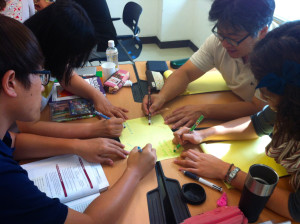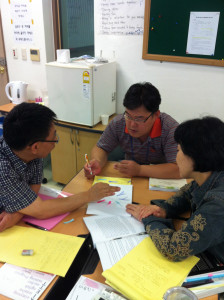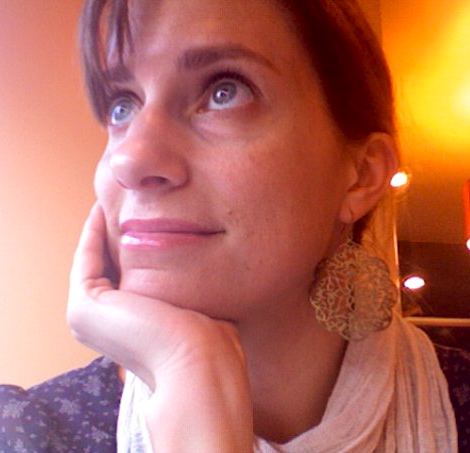Category: Critical Thinking
Critical Thinking – Josette
Critical thinking in Korean education by Josette LeBlanc
“How do you feel about learning how to write during this program?”
This is the question I ask each new English teacher who enters our in-service teacher training program. For the next five months not only will I be their trainer, I will also be their writing teacher. Without fail, the most common answer I get from these teachers ranging from age 27 to 52 is:
“I’m nervous because I haven’t learned how to write. Not even in Korean. I don’t know how to organize my ideas.”
You can imagine how compounded this anxiety gets when they start thinking about how they will have to start teaching writing in the next few years. These worries are completely understandable. Not only do most of these teachers teach to a test that promotes memorization, they were also raised in this system. In Korea, the College Scholastic Aptitude Test (CSAT), or suneung (수능), is king. It is the culmination of countless hours of rote learning, and your score determines if you will enter a university worthy of embarrassment or praise. In a country that honors such a pedagogical system, most educators have a hard time finding room for engaging their students in critical thinking: the process of observing, analyzing or questioning, and finally of coming to your own conclusions. And from what the teachers’ answer to my question about writing tells me, they might not even know where to begin.

I think there is great value in expressing what one thinks, in writing or otherwise. When we are given the chance to question and explore, we get a little closer to understanding ourselves and the world. Through this understanding we are better equipped to make decisions that will contribute to our happiness and to the well being of others. When I hear about the school violence or teen suicides in Korea, I wonder how a system that suppresses creative thought and glorifies competition contributes to these horror stories. (See Curtis Porter’s post, School Violence in Korea, for more on this topic.) I also wonder what a little more space for critical and creative thinking might do for these students.
This is the space our program tries to guide the teachers through. In writing class they analyze genres and different organizational patterns such as short stories, narratives or argumentative essays. Collaboratively, they discuss and debate topics that hit close to home: Should corporal punishment be banned from schools? Should English be removed from the CSAT? What would your dream school look like? The teachers explore grammatical or lexical structures that will help them express what they want to say. They go through the writing process. In the end, the majority of them are successful in organizing their ideas into a text I believe is quite powerful.
At the end of the five months, what they have to say about writing is along these lines:
“Not only have I learned how to write, I have learned how to think. It was a wonderful experience to think about myself as a teacher and as a person. I feel more confident about myself as a teacher and writer.”

There is no greater gift than knowing the pleasure and empowerment they got from exploring their thoughts. It gives me hope for their future and for the future of their students.
For many of these teachers, this writing experience becomes a faint memory, drowned in the test-focused system. However, some have managed to convince their principals to allow them to teach after hours writing classes. A rare few have even implemented writing skills in their curriculum. Perhaps writing itself does not always equal critical thinking, but it is a first step. I know these teachers are trying to give their students a voice. They recall the feelings they had about writing and they want their students to feel the same. I am excited to see where these seeds of thought will spread.
For more on the topic of critical thinking in Korean education, I recommend these links and articles:
- The blog of Curtis Porter, professor of the Critical Pedagogies course at Dankook University TESOL Graduate School
- Thinking Critically by iTDi mentor, James Taylor
- Why Has the Critical Thinking Movement Not Come to Korea?; article by John Michael McGuire
- Exploring the Possibilities for EFL Critical Pedagogy in Korea: A Two-Part Case Study; article by Shin HyunJung and Graham Crookes
Critical Thinking – Adam
The Role of Questions in Teaching Thinking and Learning 
by Adam Simpson
The thing I hate most about my job is the word ‘coverage’. Assessors are obsessed with coverage. If material has been covered, it can be tested. If it can be tested, it will be tested and assessors rest easy in the knowledge that they have done their job well. This naturally leads to an over emphasis on coverage at the expense of engaged thinking, based on the assumption that ‘answers’ can be taught separately from ‘questions’.
Assessors are not entirely to blame for this state of affairs. Indeed, the position that formal assessment has been allowed to take in language instruction is merely a symptom of what we are presented with in published course materials. Consider this: every declarative statement in the course books we use is an answer to a question. The teaching world in which we live frequently sees this relationship between the statement and its accompanying question. One seemingly cannot exist without the other. This is a crying shame, as it does nothing to promote thinking of any kind, never mind critical thinking.
Questions are the driving force behind critical thought
Thinking of any kind isn’t driven by answers, but rather by questions. When we learn, it is because we ask questions that stimulate thought. The trap that published course books fall into – and the trap which we follow into – is that we ask questions only to get thought-stopping answers and not to generate further questions. So, how exactly are we going wrong?
The ‘Endless Content’ monster
We feed learners with endless content and this is a big problem. Content tends to lead to questions with one answer, which in turn leads to a dead end in terms of critical thinking. One analogy I like for this phenomenon is that we are getting learners to step on the brakes of a car that is already parked. Rather than more and more content being the driving force in the classroom, what learners really need are questions that ignite their intellectual engines: they need to create questions from the questions we ask. Thinking need to go somewhere, so the questions we ask learners determine where their thinking goes. There are many types of question that stimulate critical thought:
1. Questions of purpose
These force us to define our task. Why are reading this text?
2. Questions of information
These require that we look at our sources of information as well as at the quality of our information. Who wrote this text, and why?
3. Deep questions
These drive thought underneath the surface of things; they force people to deal with complexity. What is the philosophical nature of the material we are reading or listening to?
4. Questions of interpretation
These make us examine how we are organizing or giving meaning to information. Why was the text presented in this way? What points did we place most importance on while reading?
5. Questions of assumption
These require that examine what we are taking for granted. Did the material give us new insight or challenge our accepted perceptions?
6. Questions of implication
Such questions make us follow where our thinking is going. What thoughts did this listening stimulate?
7. Questions of relevance
These force us to discriminate what does and what does not have bearing on a question. Does this reading add anything to what we know/need to know?
8. Questions of point of view
These require that we examine our perspective and to consider others’ points of view. Does this text contradict my thoughts? Does it offer new insight into the subject?
9. Questions of accuracy
These force us to evaluate and test for truth and correctness. Can/Should I take what is said in this listening at face value?
10. Questions of consistency
Such questions force us to examine our thinking for contradictions. Does everything here add up? Have I even considered the consistency of the information presented?
11. Questions of logic
These make us consider how we are putting our thoughts together, to make sure that everything adds up and makes sense within our logic system.
Dead minds come from dead questions
The superficial questions we constantly see in published teaching materials result in superficial understanding. Most students typically have no questions: their minds are silent. Any questions they do have are often superficial to say the least. Don’t blame them for this; it is a natural symptom of how they have been taught to learn. Lack of questioning shows us that they are not thinking through the content they are apparently ‘learning’. Indeed, they are not really even learning the content we think they are learning.
Fortunately, we can fix this: thinking begins when questions are formed by both teachers and students. My advice would be to approach coursebook material with your learners and see what questions from the eleven types mentioned above you – together – come up with.
Critical Thinking – Vladimira
 My Inner Velvet Revolution
My Inner Velvet Revolution
by Vladimira Chalyova
“Any growth requires a temporary loss of security”– Madeline Hunter
As scary as it may sound, critical thinking is neither a threat to a teacher nor another skill to learn for a student. Yet just like happiness, it seems to be difficult to understand, grasp or achieve. My comparison to happiness is not accidental, though. Both critical thinking and happiness have a couple of things in common and I believe that the same kind of journey leads towards them.
- It is something we long for but don’t necessarily know how to get there.
- The farther we get, the more complex it becomes.
- It follows the inside – out principle
(we won’t see it out there unless we find it inside ourselves)
- It enriches the life of an individual as well as the community.
As teachers we can’t teach critical thinking. However, we can facilitate and equip our students with skills and help them develop abilities so that they do the exploration for themselves.
For me, the exploration into the realm of my own critical thinking was almost like a revolution. Not an aggressive or turbulent one. Quite the opposite! I come from a country, Slovakia, which is famous for its peaceful separation – the Velvet Revolution. I like to think the similar process happened inside me as well.
As a child I almost always followed the rules, mostly because they were not just given to me as an order, but explained to me as something that was there for all to create an environment where everyone can learn the importance of each other – the meaningful and relevant rules, for a nourishing and safe environment, of course. At the same time I was given enough time to explore my interests and enough freedom to change them as I grew up. I was a member of all kinds of clubs, attended various courses or activities until I, myself, found out what filled me most with the sense of curiosity and drive.
It is not that much about the things we are good at or we like that help us develop our critical thinking. Rather, it is what we find challenging, what pushes us forward to break barriers inside!
This way I was building my own understanding of things and reality. I was building my own point of view and more importantly, the way to explain it to others. I found out I was well able to form my own “state” within the community of others, accepting others and at the same time not giving up on what I believed in.
Please, don’t forget this important element of acceptance along your journey!
I think that forgetting it or leaving it behind is why we have started relating critical thinking to a threat or even something negative such as criticism. Acceptance should be always mutual! You do your part by being a model for others; don’t force them.
I accept that you face challenges on your way and you accept that mine are most likely to be different than yours!
All of us face them as we move forward, maybe in a different direction or pace, but we all do!
And have I reached the destination of my journey – exploration?
Does it all end once we become independent?
Does happiness end once you find the source? Of course not!
It is never too late or too early to embark and in a quiet moment reach deep and find what challenge you need to overcome this time to move forward. The journey itself, every step forward towards the new understanding of yourself and the world is a reward. Let your students see that you, too, are on the way and be an inspiration where it may lead them.
Critical Thinking – Wawan
 Reading Skills: A Missing Link in the Teaching of Critical Thinking Skills – Wawan Setiawan
Reading Skills: A Missing Link in the Teaching of Critical Thinking Skills – Wawan Setiawan
Critical Thinking has been considered one of the necessary skills that students must acquire. Thus, it is believed that teaching this skill in our classroom – whatever discipline we are teaching – will help our students to scrutinize any “underlying issues” some steps beyond any surface phenomenon they encounter. The process of this high level of thought is predetermined by the intelligence recreation in which the students are demanded to go through a much lengthened and demanding thought processing that involves higher level of concentration, incorporation of knowledge of the world, sharpened questions, formulation of hypothesis, and other information to direct to. Critical thinking skills training embedded to the teaching of language skills lays the foundation crucial to establishing strong grounds on the basis of which language learners can extrapolate broad connections of some phenomena. The true sense of bringing a communication gap to class is most realistically materialized when the teaching of language skills sheds conjuring ideas during a critical analysis or discussion on the matters that students find highly related to their lives.
However, in the Indonesian classroom context, to integrate critical thinking into language teaching poses great challenges. Culturally speaking, being critical has long been labeled as an act of impoliteness. In the homes of many families children are predominantly dogmatized that having critically different ideas towards their elders is deemed taboo. Family rules are viewed as parents’ prerogatives to shape acceptably-mannered children. The consequence leads to the creation of students having stumbling blocks to articulate opinions, not to the extent that they have no idea but to that they are afraid of getting bad labels. Another challenge facing the integration of critical thinking into language teaching is the fact that the reading habit does not take root in the lives of most students. Meanwhile, reading activity does not take place on the students’ own accord. It’s a mandated or imposed activity as part of any given curricular scheme, many of which are not aimed at fostering comprehension skills on the part of the students and with the reading materials going far beyond the students’ interest. They stop reading when the obligatory mission is accomplished. To my understanding, such realization of reading assignments is not the nature under which an extensive reading program is supposedly carried out for a valuable reading activity to take place. As critical thinking is a high order thinking activity that requires them to incorporate their knowledge of the world in critically analyzing any given phenomenon, asking students to become involved in a classroom demanding critical analysis in which they have to put their internalized knowledge to show how to anticipate a new problem and to cope with that is impossible to manifest when students lack an understanding of what happens around their lives.
A hope is still there if we go extra miles regarding this, and the choice is clear, that is, to adopt reading instruction approaches that could help students coalesce reading skills important to the development of students’ critical thinking skills and that provide missing channels for articulating opinions. Such approaches may take any of several forms.
1. Building Circles of Critical Readers
Encourage students to engage in critical reading activities by dedicating special rooms in the real world as well as in the virtual world. The reading selections of different genres are not only to be interesting to the students but also to be accompanied by tasks. These tasks are meant to be stimulus for the students to activate their thinking faculties. Regular posts on the school’s wall bulletin on different discussion topics followed by the chained responses contributed by students will reduce the feeling of being obliged to answer reading comprehension questions as compared to the same mechanism done in the classroom. The era we live in now even offers more attractive platforms in the virtual world in which our students are even better at doing. What lies ahead of us is facilitating them for the maximum use of technology.
2. Realigning Students’ Motivation Doing In and Out of the Class Reading Activities
It’s not a big problem whether the motivation to read is extrinsic or intrinsic. As most of the students’ time is spent outside the class, our main job as a language teacher is make sure that they are provided with reading materials that are interesting, familiar but challenging, have connections with their lives, enlighten them so that they find them useful in preparing their future, lend themselves to vocabulary development, indigenous in developing students’ reading micro skills, and allow the promotion of reading fluency. Meanwhile, what happens in the classroom should be the sort of reading instruction that will empower students in doing out of the class reading activities, in which the reading classroom interactions are geared towards not only the teaching of how to comprehend texts but also the training of how comprehension is achieved through the application of reading micro-skills. Embedding productive aspects of the language with reading instruction is really worth an effort. Teachers may develop questions that ask students to relate the reading content with those incidents they encounter in their daily lives.



